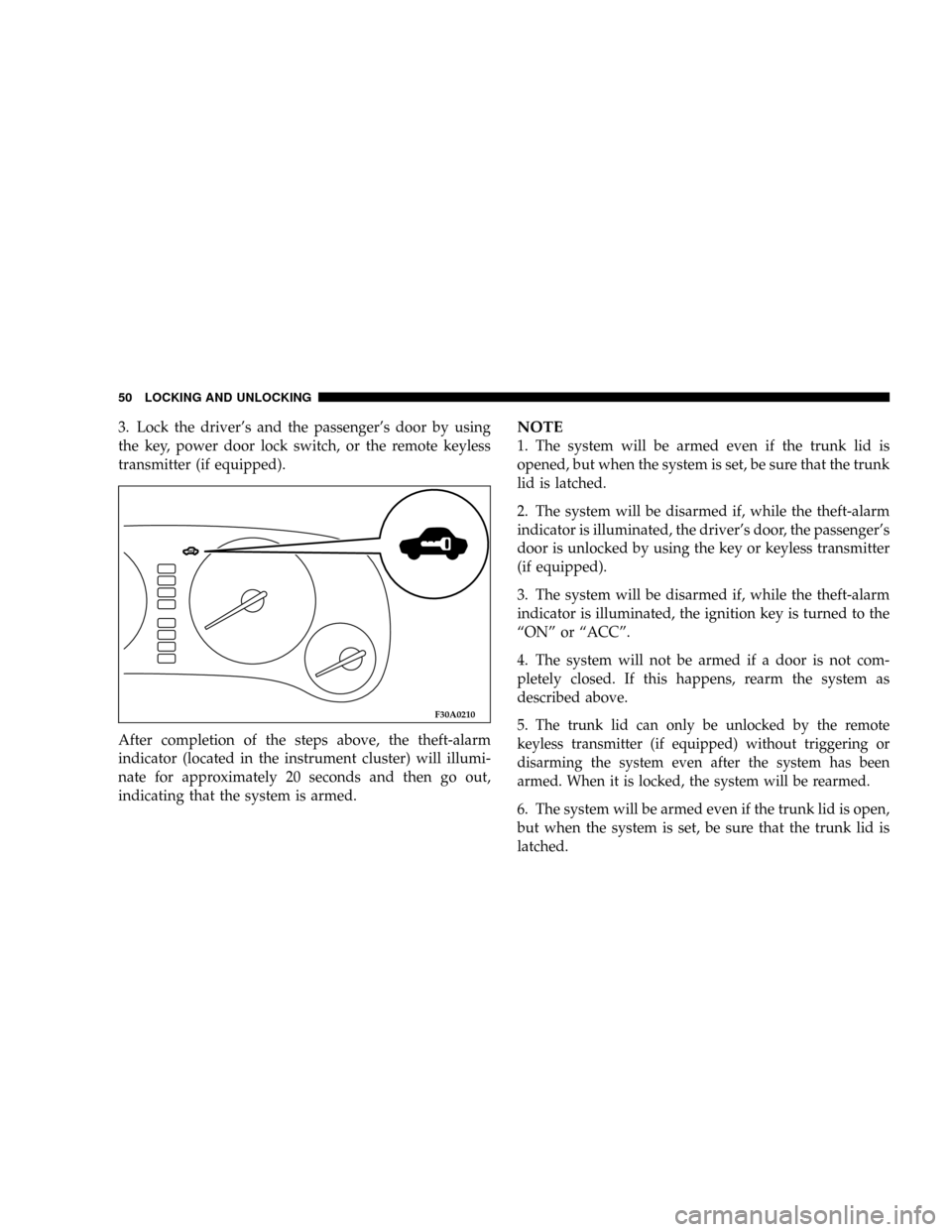Page 46 of 396
Passenger switch
The passenger switch can be used to operate the passen-
ger door window.
SUNROOF (IF SO EQUIPPED)
The sunroof can be opened and closed with the ignition
key in the ªONº position.
To tilt up
When the sunroof switch (1) is pressed, the back of the
sunroof automatically goes up for inside ventilation.
To stop the sunroof partway, push the sunroof switch (2).
F17A1610F19A0960
46 LOCKING AND UNLOCKING
Page 47 of 396

NOTE: Before tilting the sunroof, completely open the
sunshade. Otherwise you will not have good ventilation.
To tilt down
Press the sunroof switch (2).
To stop the sunroof partway, release the sunroof switch.
To open
When the sunroof switch (1) is pressed, the back of the
sunroof automatically goes up.
When the sunroof switch (1) is pressed a second time, the
sunroof automatically opens completely.
To stop the sunroof partway, press the sunroof switch (2).
To close
The sunroof closes while the sunroof switch (2) is being
pressed.
To stop the sunroof partway, release the switch.
NOTE
1. The sunroof can be operated when the ignition key is
in the ªONº position. The sunroof can be opened or
closed for a 30-second period after the ignition switch is
turned off. However, once the driver 's door or the
passenger 's door is opened, the sunroof cannot be oper-
ated until the ignition switch is turned on again.
2. If the battery cable is disconnected or the fuse is
replaced while the sunroof is open, the sunroof will not
close normally even after reconnecting the battery cable.
In this case, use the following steps.
Press the switch (2) repeatedly to close the sunroof
completely. The sunroof will resume its normal operation
after this procedure is completed.
LOCKING AND UNLOCKING 47
2
Page 50 of 396

3. Lock the driver's and the passenger's door by using
the key, power door lock switch, or the remote keyless
transmitter (if equipped).
After completion of the steps above, the theft-alarm
indicator (located in the instrument cluster) will illumi-
nate for approximately 20 seconds and then go out,
indicating that the system is armed.NOTE
1. The system will be armed even if the trunk lid is
opened, but when the system is set, be sure that the trunk
lid is latched.
2. The system will be disarmed if, while the theft-alarm
indicator is illuminated, the driver's door, the passenger's
door is unlocked by using the key or keyless transmitter
(if equipped).
3. The system will be disarmed if, while the theft-alarm
indicator is illuminated, the ignition key is turned to the
ªONº or ªACCº.
4. The system will not be armed if a door is not com-
pletely closed. If this happens, rearm the system as
described above.
5.
The trunk lid can only be unlocked by the remote
keyless transmitter (if equipped) without triggering or
disarming the system even after the system has been
armed. When it is locked, the system will be rearmed.
6. The system will be armed even if the trunk lid is open,
but when the system is set, be sure that the trunk lid is
latched.
F30A0210
50 LOCKING AND UNLOCKING
Page 51 of 396

7. The driver should not arm the system until first
confirming that all passengers have left the vehicle. If the
driver arms the system while a passenger(s) in the
vehicle, the alarm may be activated when the passen-
ger(s) leave the vehicle.
Alarm stage
The alarm will be activated if any of the following occur
while the vehicle is parked and the system is armed.
1. The driver's or passenger 's door is opened without
using the key or the remote keyless transmitter (if
equipped).
2. The trunk lid is opened without the remote keyless
transmitter (if equipped).
TYPE OF ALARM
When the alarm is activated:1. The headlights blink on and off for 3 minutes. After 3
minutes the headlights automatically shut off.
2. The horn will sound intermittently for 3 minutes.
NOTE: The alarm will continue to operate for 3 minutes.
At the end of that period, the alarm will automatically
shut off to save battery power. The system will then be
rearmed until the proper disarming step is taken.
F30A0020
Horn sounds!
Headlights blink on and off!
LOCKING AND UNLOCKING 51
2
Page 52 of 396
Alarm deactivation
The alarm can be deactivated in the following ways.
1. By turning the key (in the driver's or passenger 's
door) in either direction (toward lock or unlock).
2. By using the remote keyless transmitter (if equipped)
to lock or unlock the door or trunk lid.
Disarmed stage
The system will be disarmed when either of the following
steps are taken:
1. The front driver's door, passenger's door or the trunk
lid is unlocked by using the key or the remote keyless
transmitter (if equipped).
2. The ignition key is turned to the ªACCº or ªON º
position.
F30A0040T
Disarm....by key (or by keyless transmitter)
52 LOCKING AND UNLOCKING
Page 53 of 396

3. If the UNLOCK button is pressed when all doors are
closed and no door is opened within approximately 30
seconds, re-arming will automatically occur.
NOTE: Once the system has been disarmed, it cannot be
rearmed except by repeating the arming procedure.
Testing the theft-alarm system
Use the following procedure to test the system:
1. Lower the driver's window.
2. Arm the system as explained in ªArmed stageº.
3. Make sure that the theft-alarm indicator illuminates
and goes off in approximately 20 seconds.
4. Wait a few seconds and then unlock the driver's side
door by using the inside door lock knob and opening the
door.
5. Check to be sure that the horn sounds intermittently
and the headlights blink on and off when the door is
opened.6. Disarm the system by unlocking the front driver's
door, passenger's door or the trunk lid by using the key
or the remote keyless transmitter (if so equipped).
NOTE: To make sure the alarm sounds when the trunk
lid is opened, open the trunk lid by using the trunk lid
release lever.
LOCKING AND UNLOCKING 53
2
Page 57 of 396

Your vehicle has seat belts and other features that help
protect you and your passengers in an accident.
Seat belts are the most important safety device. When
worn properly, seat belts can reduce the chance of serious
injury or death in various types of crashes. For added
protection during a severe frontal collision, your vehicle
has a Supplemental Restraint System (SRS) with air bags
for the driver and front seat passenger. The seats, head
restraints, and door locks also are safety equipment,
which must be used correctly.
Always check the following before you drive:
7. Everyone in the vehicle is properly wearing their seat
belt.
8. Infants and small children are properly secured in
appropriate child restraints in the rear seat.
9. All doors are closed and locked.
10. Seat backs are fully upright, with head restraints
properly adjusted.No safety equipment can prevent all injuries or deaths
that can occur in severe collisions, but by making sure all
your passengers follow the instructions in this manual,
you can help reduce the risk of injury.
FRONT SEATS
Adjust the driver's seat as far back as possible to a
position that enables you to fully apply the pedals, easily
control the steering wheel, safely operate the vehicle and
also gives you a clear frontal view.
G21A0680
SEATS, SEAT BELTS, CHILD RESTRAINTS AND AIR BAGS 57
3
Page 68 of 396

SEAT BELTS
Seat belts are installed in your vehicle for the protection
of the driver and passengers.
Always use the seat belts. In an accident, injury to the
driver and passengers may be reduced if the seat belts are
properly used.
NOTE: Legislation in your state may require seat belt
usage; however, even if it is not required seat belts should
always be used.
WARNING!
²Lock all doors before driving to reduce the risk of
injury or ejection in a collision.
²Seat belts should always be worn by every adult who
drives or rides in this vehicle, and by all children
who are large enough to wear seat belts properly.
²Never use one seat belt for more than one occupant.
²Never carry more people in the vehicle than there
are seat belts.
²Always adjust the belt for a snug fit.
²Always route the shoulder belt over your shoulder
and across your chest. Never put it behind you or
under your arm.
²Always wear the lap belt as low as possible across
your hips, not around your waist.
²To reduce the risk of serious or fatal injury in a
collision, including from a deploying driver air
bag, the driver should adjust the driver's seat to
the rear most position that still allows good vis-
ibility and good control of the steering wheel, the
brake, accelerator, and vehicle controls.
68 SEATS, SEAT BELTS, CHILD RESTRAINTS AND AIR BAGS